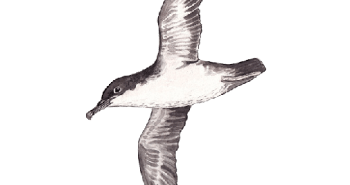
Manx shearwater
(Puffinus puffinus)
The Manx shearwater belongs to the seabird family Procellariidae (Shearwaters). They are medium-sized birds that spend almost their entire lives at sea. As a highly pelagic species, the Manx only comes to land to breed. It belongs to the order of tubenoses.
It belongs to the order of tubenoses which includes the albatrosses, the storm petrels and the shearwaters. Tubenoses were named after the two tubular nasal passages in the beak, through which can excrete salt.
In former times, several species were considered to be only one subspecies of the Manx shearwater. Today there are eight species, which are autonomous.
Their beak is long and hooked, with sharp edges. Like all other tubenoses, Manx shearwaters are well adapted to long-distance flight and can cover huge distances and endure severe storms.
This seabird can be seen in Madeira during the breeding season between March and October.
General information
Further names: Portuguese: Fura-buco-do-Atlantico; English: Atlantic puffin
Food: Small fish (herrings, sprats, sand eels), crustaceans, cephalopods.
Habitat and range: Atlantic ocean; breeding colonies at cliff lines (Great Britain: west coast of wales; island of Rum); the Azores; Madeira (also Selvagens Islands); Canary Islands; Breton coastline; Central European coasts (visitor). Males are phillopatric, returning to the colonies in which they were hatched but up to half of females may move elsewhere.
Distinctive features: up to 30–38 cm; with a 76–89 cm wingspan and weighs 350–575 g. Typically “shearing” flight of the genus, dipping from side to side on stiff wings with few wingbeats with their wingtips almost touching the water.
Ecology: The birds nest in colonies, mostly in rock caves and crevices in cliff faces. One clutch a year consisting of a single egg (May, June). These birds are monogamous and always attempt to pair up with the same mate from the previous breeding season and also prefer returning to the same nesting colony as the previous year. The incubation period is 51 to 61 days. Chicks hatch complete with downy plumage and have a relatively slow growth, leaving the nest only after two to nine months. At the beginning, one parent bird is constantly with the chick until the young animal reaches a certain size, demanding both parent birds to leave the nest in search for food. When feeding, the parent bird grabs the beak of the chick at a right angle and regurgitates its prey to feed the chick. During the breeding season, the vocalisations of the parent birds can be easily heard within a short distance from the nesting sites. In flight, they give out a loud, wailing call. The parents only return to feed their chicks at nighttime. They have an impeccable sense of smell, detecting potential prey at a distance of several tens of kilometres.
Taxonomy: Class: Aves; Order: Procellariiformes; Familly: Procellariidae
Genus: Puffinus; Species: Puffinus puffinus
Threats: In the past this species was exploited leading to significant decreases in their populations. Today invasive species such as rats, cats and livestock present the greatest threat along with light pollution. The species is listed as vulnerable in Madeira.
